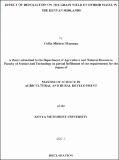Effect of Defoliation on the Grain Yield of Hybrid Maize in the Kenyan Midlands
Abstract
Maize is an important agricultural commodity in the Kenyan midland grown by about 70% of farmers as food crop. Majority of these are small scale holders practicing mixed farming i.e. crop and livestock production as a major source of income. These areas experience fodder shortage due to diminishing land size as a result of increased population. The purpose of this study therefore was to (i) Quantify the impact of defoliation on the final grain yield of hybrid maize and (ii) Quantify the amount of forage obtained at various levels of defoliation done after anthesis. (iii) To assess the best method of defoliating the maize crop after anthesis. The levels of treatment were removal of 25%, 50% and 75% of leaves of the hybrid maize removed from the bottom. There were two sampling schemes of defoliation and each was replicated four times (treatments). In the sampling scheme I defoliation was done once at anthesis, where by 25%, 50% and 75% of the total leaves were removed. In sampling scheme II defoliation was done in stages at interval of two weeks after anthesis, the defoliation rate was 25% of the total leaves. The main study findings revealed that increasing leaf defoliation decreases grain yields while increasing the quantity of fodder from the maize plants. When defoliation is done in phases at 25% intervals then yields are reduced but not greatly reduced as compared to when done at once. Striking a balance between maximizing fodders without compromising the grain yields is a desirable phenomenon of subsistence farming in midlands. This study therefore concluded that 50% defoliation to be done in phases on the other hand it recommends that 75% and above defoliation should not be done on maize crops because this treatment reduces the grain yield significantly.
Publisher
KeMU

